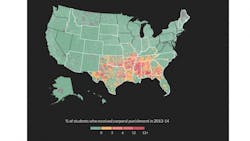Education secretary urges states to end corporal punishment of students
Saying corporal punishment has been linked to harmful short-term and long-term outcomes for students, U.S. Education Secretary John B. King Jr. is urging states to end the practice.
In a letter Tuesday to governors and chief state school officers, KIng says that although "some may argue that corporal punishment is a tradition in some school communities, society has evolved, and past practice alone is no justification.
"No school can be considered safe or supportive if its students are fearful of being physically punished.," King writes. "We strongly urge states to eliminate the use of corporal punishment in schools—a practice that educators, civil rights advocates, medical professionals, and researchers agree is harmful to students."
Corporal punishment has been banned in 28 states and Washington, D.C. In addition, the practice has been abandoned by individual districts in states that still permit corporal punishment. Still, more than 110,000 students across the nation were subjected to corporal punishments in 2013-14, according to the education department’s Civil Rights Data Collection.
The department says a consensus has been formed among teachers’ groups, the PTA, medical and mental health professionals, and civil rights advocates that corporal punishment "has no place in our schools."
Eighty organizations are releasing a letter this week calling on states and policymakers to end the practice.
“It is a disgrace that it is still legal in states to physically punish a child in school," says Fatima Goss Graves, senior vice president for program at the National Women’s Law Center. "Students are subject to corporal punishment for something as minor as cell phone use or going to the bathroom without permission. And students of color and students with disabilities are disproportionately victims of physical punishment."
Corporal punishment in school is associated with poorer academic outcomes. Research indicates that corporal punishment can affect students’ cognitive functions, lessening brain development, verbal ability, problem-solving skills and academic achievement.
The Civil Rights Data Collection also shows that corporal punishment is used overwhelmingly on male students and is much more commonly administered to African-American students of either sex.
In nearly all of the states where the practice is permitted, students with disabilities were subjected to corporal punishment at a higher rate than students without disabilities.
About the Author
Mike Kennedy
Senior Editor
Mike Kennedy, senior editor, has written for AS&U on a wide range of educational issues since 1999.
